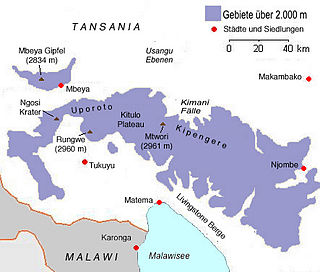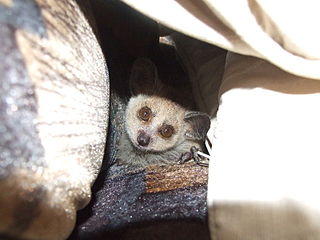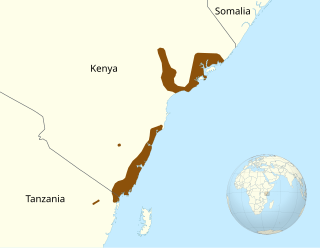
The Zanzibar bushbaby, Matundu dwarf galago, Udzungwa bushbaby, or Zanzibar galago is a primate of the family Galagidae. An adult typically weighs 150 grams (5.3 oz), its head-body length is 14 to 15 centimetres and its tail is between 12 and 15 centimetres long. Like other species of galagos, its diet consists mainly of fruit, insects, and tree gums.

Mbeya Region is one of Tanzania's 31 administrative regions. The region covers an area of 35,954 km2 (13,882 sq mi). The region is comparable in size to the combined land area of the nation state of Guinea Bissau. Mbeya Region is bordered to the east by Singida Region, Iringa Region and Njombe Region. The region is bordered to the south by Malawi and Lake Nyasa. To the north the region borders southern Tabora Region. Lastly, Mbeya is bordered to the west by Songwe Region. The regional capital is the city of Mbeya. According to the 2012 national census, the region had a population of 2,707,410.
The Kipengere Range, also known as the Livingstone Mountains, lies entirely in Njombe Region in southwest Tanzania at the northern end of Lake Nyasa. Near Lake Nyasa they are known as the Kinga Mountains. It is a plateau-like ridge of mountains running southeastwards from the basin of the Great Ruaha River in the north to that of the Ruhuhu River in the south, and forms part of the eastern escarpment of the East African Rift. The range is mostly clad in montane grasslands, renowned for their botanical diversity and displays of flowers, with montane evergreen forests mostly in stream valleys.

Mount Rungwe is a volcanic mountain in Mbeya Region, in Tanzania's Southern Highlands. At an altitude of 2,981 metres (9,780 ft), it is southern Tanzania's second-highest peak. Rungwe's volcano is currently inactive.

Tukuyu, known as Neu Langenburg during the German colonial rule, is a hillside town that lies about 36 miles (58 km) south of the city of Mbeya, at an elevation of around 5,000 ft (1,500 m) in the highland Rungwe District of southern Tanzania, East Africa. Tukuyu town has a moderate to cool temperature ranging from 10 °C in May and June to mid 20 °C in around November. The town and surrounding areas are green all year round due to the almost year-round convectional rains resulting from Lake Nyasa(Lake Malawi).Tukuyu town is divided into several wards include; Kawetere, Msasani, Bulyaga and Bagamoyo.

The Taita Hills, sometimes also spelled as Teita Hills, are a mountain range located in the Taita-Taveta County in south-eastern Kenya. The hills consist of three massifs: Dawida, Sagalla in the southern side of Voi township and Kasigau in the south near the border of Tanzania. The Dawida massif is the largest and tallest of the three, with an altitude of 2,228 metres (7,310 ft) above sea level at its highest peak, Vuria. Dawida has three other main peaks: Iyale, Wesu, and Susu.
The Kipengere seedeater, also known as the Tanzania seedeater, is a species of finch in the family Fringillidae. It is found only in Tanzania specifically in Mbeya Region and Njombe Region. Its natural habitats are subtropical or tropical moist montane forest and subtropical or tropical high-elevation shrubland. It is threatened by habitat loss.

Grant's bushbaby, also known as Grant's lesser bushbaby or the Mozambique lesser bushbaby, is a species of primate in the family Galagidae. It is found in Malawi, Mozambique, Tanzania, and Zimbabwe. Its natural habitat is subtropical or tropical dry forests. It is a common species and the International Union for Conservation of Nature has assessed its conservation status as being of "least concern".

The Uluguru bushbaby, also known as the mountain dwarf galago or the Amani dwarf galago, is a species of primate in the family Galagidae. Like all galagos, it is a strepsirrhine primate. It is endemic to the Eastern Arc Mountains of Kenya and Tanzania at altitudes of 1,200 - 2,000 m. It has its own set of unique calls, which helps distinguish it from other species of bushbaby.

The Rondo dwarf galago or Rondo bushbaby is a species of primate in the family Galagidae. The dwarf galagos are the smallest members of the genus Galagoides. It weighs less than 100 grams, making it the smallest known galago. It is endemic to Tanzania where its natural habitat is subtropical or tropical dry forests. It lives in an area reported in 2012 to be less than 100 square kilometers and is threatened by habitat loss due to logging. While it was discovered in the 1950s, the Rondo dwarf galago was deemed data deficient until 1996. In 1996, the Rondo dwarf galago was fully described as a species. It is now listed as one of "The World's 25 Most Endangered Primates."

Kihaule's mouse shrew is a species of mammal in the family Soricidae endemic to Tanzania where it is known only from the Udzungwa Mountains, at the western end of the Eastern Arc Mountains. Its natural habitats are subtropical or tropical moist montane forests and plantations. It is threatened by habitat destruction and the International Union for Conservation of Nature has assessed its conservation status as being "endangered". It was named after Philip M. Kihaule, a medical-entomological technician, who considerably contributed to the documenting of the small mammals of Tanzania and collected the type specimen of this shrew.
The Poroto Mountains are a mountain range in the Mbeya Region of Tanzania. They are located east of the city of Mbeya. The Poroto Mountains are a northwestward extension of the Kipengere Range, and part of the Southern Highlands. The Poroto mountains are volcanic in origin, part of the geological Rungwe Volcanic Province.

Kitulo National Park is a protected area of montane grassland and montane forest on the Kitulo Plateau in the southern highlands of Tanzania. The park is at an elevation of 2,600 metres (8,500 ft) between the peaks of the Kipengere and Poroto mountains and covers an area of 412.9 square kilometres (159.4 sq mi), lying in Mbeya Region and Njombe Region. The park is administered by Tanzania National Parks (TANAPA) and is the first national park in tropical Africa to be established primarily to protect its flora.
The Southern Highlands is a highland region in southwestern Tanzania, at the northern end of Lake Malawi. The highlands include portions of Mbeya, Njombe, Rukwa, Ruvuma, and Songwe regions, bordering Malawi, Mozambique, and Zambia. Mbeya is the largest city in the highlands.
Mbeya Range is a volcanic mountain range in Mbeya Region, in southwestern Tanzania, East Africa. It forms an arc just north of the town of Mbeya and includes Loleza Peak, Mbeya Peak, Nyanuwa Peak, and Pungulumo. The range is at the junction of the eastern Gregory Rift and western Albertine Rift valleys. and is in Rungwe volcanic province. The Songwe Scarp terminates the Rukwa Trough at its southeast end and forms the northwestern side of the Mbeya Range.
Mpanga-Kipengere Game Reserve is a protected area in Njombe Region of the Southern Highlands, Tanzania. It covers an area of 1,574 km2 (608 sq mi) and ranges in elevation from 1,800 to 2,289 m. In addition to the preservation of wildlife the reserve is an important catchment for the headwaters of several rivers that feed into the Great Ruaha River and provide water for the Usangu wetlands.

The Kenya coast galago is a species of primate in the family Galagidae. It is found across Kenya and Tanzania, particularly around the northern coastal area of each of the countries, and has been located living from sea level to around 350 metres (1,150 ft) above sea level.

The Angolan dwarf galago is a species of dwarf galago native to Angola, and was named after western Angolan Kumbira Forest. Though 36 individuals of the Angolan dwarf galago were identified in September 2013, it was declared as a new species in 2017, and is now the nineteenth species of galago to be identified. Its call, described as "A loud chirping crescendo of longer notes, followed by a fading twitter", was enough to separate it as a new species, without any genetic identification, due to its uniqueness.

The South Malawi montane forest-grassland mosaic is a montane grasslands and shrublands ecoregion of Tanzania, Malawi, Mozambique, and Zambia.

The eastern dwarf galagos are a group of five species of strepsirrhine primates of the family Galagidae, native to East Africa. They were formerly classified in the genus Galagoides but have been moved to their own genus, Paragalago, based on genetic evidence, and supported by differences in vocalizations and morphology. The three western/Congolian species remain in Galagoides.












